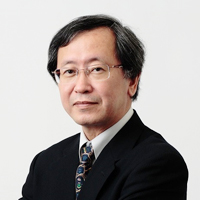Title of Presentation
“Strong Correlation between Electricity and Magnetism in Materials”
Electromagnetism describing the interaction between electric and magnetic fields was established within the 19th Century. Nowadays, our human being can make great use of electric energy that is generated via the energy transformation based on Faraday’s electromagnetic induction and transmitted through electric cables or in form of electromagnetic wave. However, it is only 135 years ago when the world established and began to distribute the infrastructure of the electric power transmission system. Recently there is ever increasing trend of electric power consumption partly owing to the explosive development of information technology. Therefore, we are forced to explore the more efficient ways to create, transmit, save, and use the electric energy, which should be most important subjects of materials science and technology for the human being to work on hereafter over the time span even more than 100-200 years.
Let us turn our eyes to the materials where roles of entanglement between electricity and magnetism in solid, in analogy to the electromagnetic induction in free space, become important; therein a vast number of electrons are strongly interacting with each other. While motion of one electron can be precisely described by quantum mechanics, it needs the higher-hierarchy concept and methodology to understand and explore new properties and functions emerging from these correlated electrons. With use of correlated electrons and their forming topology, it becomes capable to control mutually electricity and magnetism in materials. For example, the utterly electrically-insulating materials can be turned in to the metal with good electrical conduction by applying magnetic field, and the application of electric field (not current) can create a magnet within the material. This is a sort of phase transition of electrons, like the ice to water phase transition of water molecules. We dream the emergent electromagnetism in a solid by exploiting strongly correlated electrons which enable us to transform the energy form with ultrahigh efficiency and mitigate ultimately the energy cost for information technology.
Profile
- Web Site URL
- http://www.cmr.t.u-tokyo.ac.jp/index_e.shtml
http://www.cems.riken.jp/en/?lang=en - A brief Biography
-
1976 B.S., Dept. of Applied Physics, University of Tokyo 1981 Ph.D., Dept. of Applied Physics, University of Tokyo 2013 – Present Director, RIKEN Center for Emergent Matter Science 2008 – Present AIST Fellow, National Institute of Advanced Industrial Science and Technology (AIST) 2007 – 2013 Group Director, Cross-Correlated Materials Research Group RIKEN 2006 – 2012 Research Director, Multiferroics Project (MF), Exploratory Research for Advanced Technology Organization (ERATO), JST 2001 – 2008 Director, Correlated Electron Research Center (CERC), AIST 2001 – 2007 Research Director, Spin Superstructure Project (SSS), Exploratory Research for Advanced Technology Organization (ERATO), JST 1995 – Present Professor, Dept. of Applied Physics, University of Tokyo 1994 – 1995 Professor, Dept. of Physics, University of Tokyo 1993 – 2002 Group Leader, Joint Research Center for Atom Technology (JRCAT) 1986 – 1993 Associate Professor, Dept. of Physics, University of Tokyo - Details of selected Awards and Honors
-
1990 Nishina Memorial Prize 1991 Bernd Matthias Prize 1998 Nissan Science Prize 2002 Asahi Prize 2003 Medal with Purple Ribbon 2005 James C. McGroddy Prize for New Materials 2011 Fujihara Prize 2012 IUPAP Magnetism Award and Néel Medal 2013 The Imperial Prize and Japan Academy Prize 2014 Honda Memorial Award - A list of selected Publications
-
J.B. Torrance, Y. Tokura, A.I. Nazzal, A. Bezinge, T.C. Huang, and S.S.P. Parkin: “Anomalous disappearance of high-Tc superconductivity at high hole concentration in metallic La1-xSrxCuO4”, Phys. Rev. Lett. 61, 1127 (1988).
Y. Tokura, H. Takagi, and S. Uchida: “A superconducting copper-oxide compound with electrons as the charge-carriers”, Nature 337, 345 (1989).
Urushibara, Y. Moritomo, T. Arima, A. Asamitsu, G.Kido, and Y. Tokura: “Insulator-metal transition and giant magnetoresistance in La1-xSrxMnO3”, Phys. Rev. B 51, 14103 (1995).
Y. Moritomo, A. Asamitsu, H. Kuwahara, and Y. Tokura: “Giant magnetoresistance of manganese oxides with a layered perovskite structure”, Nature 380, 141 (1996).
Asamitsu, Y. Tomioka, H. Kuwahara, and Y. Tokura: “Current switching of resistive states in magnetoresistive manganites”, Nature 388, 50 (1997).
K.L. Kobayashi, T. Kimura, H. Sawada, K. Terakura, and Y. Tokura: “Room-temperature magnetoresistance in an oxide material with an ordered double-perovskite structure”, Nature 395, 677 (1998).
T. Kimura, T. Goto, H. Shintani, K. Ishizaka, T. Arima, and Y. Tokura: “Magnetic control of ferroelectric polarization”, Nature 426, 55 (2003).
S. Ishiwata, Y. Taguchi, H. Murakawa, Y. Onose, Y. Tokura: “Low-Magnetic-Field Control of Electric Polarization Vector in a Helimagnet”, Science 319, 1643-1646 (2008).
X.Z. Yu, Y. Onose, N. Kanazawa, J. H. Park, J. H. Han, Y. Matsui, N. Nagaosa and Y. Tokura: “Real-space observation of a two-dimensional skyrmion crystal”, Nature 465, 901-904 (2010).
S. Seki, X.Y. Yu, S. Ishiwata and Y. Tokura: ” Observation of Skyrmions in a Multiferroic Material “, Science 336 198-201 (2012).






